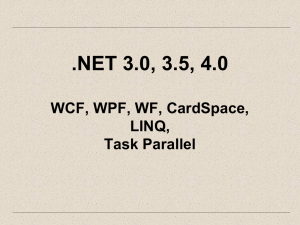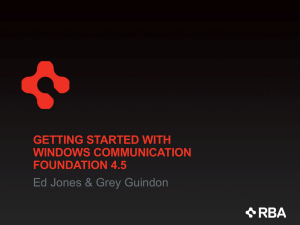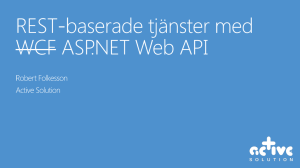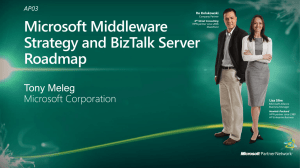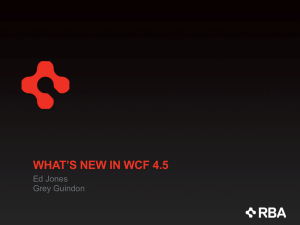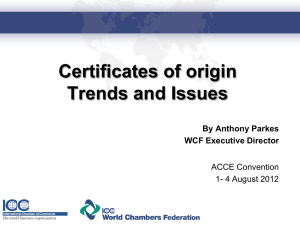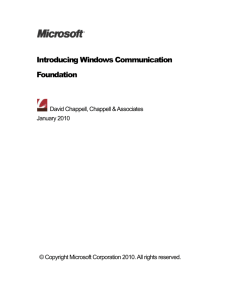Working Capital Fund Presented by: Paul J. Dominick, CDFM
advertisement
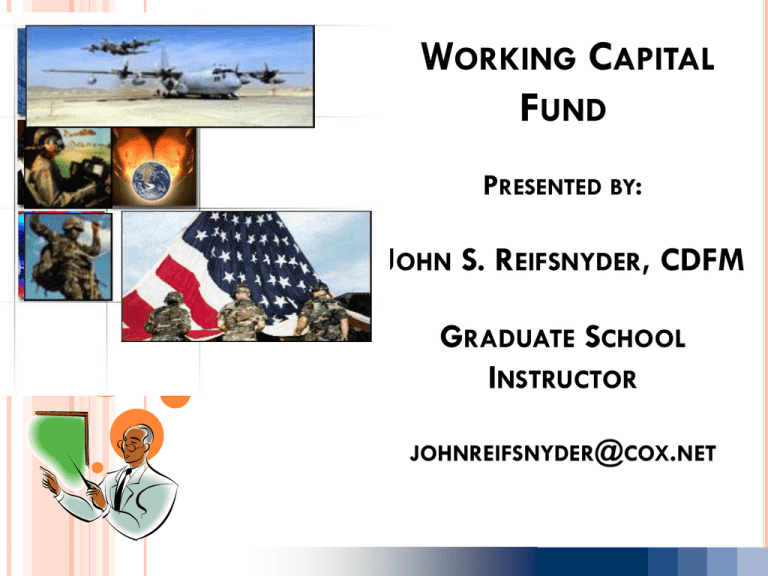
WORKING CAPITAL FUND PRESENTED BY: JOHN S. REIFSNYDER, CDFM GRADUATE SCHOOL INSTRUCTOR 1 JOHNREIFSNYDER@COX.NET WORKSHOP FOCUS History of Working Capital Funds (WCF) Organizations Utilizing WCFs Myths About WCFs Basic Concepts of WCFs Little or No Appropriated Funds Business-Like Budget Formulation and Execution Cost Accounting Stabilized Rates No-Year Funding Financial and Operational Concepts and Statements 2 HOOVER COMMISSION RECOMMENDATIONS Resulted in passage of The National Security Act of 1947 Business /Commercial type activities of the military departments are to be financed by revolving or working capital funds Established the Office Of The Secretary Of Defense and the Department Of The Air Force Created Comptroller positions with overall responsibility for financial systems Created Joint Chiefs of Staff 3 WORKING CAPITAL FUND HISTORY AUTHORIZING LEGISLATION Public Law 81-216 National Security Act of 1947 Codified in 10 USC 2208 The law authorized working capital funds to provide financing of industrial-commercial type activities, and to effectively control cost of programs and work performed Implemented by several DoD Financial Management Regulations 4 WORKING CAPITAL FUND EVOLUTION 1947 – National Security Act of 1947 authorized establishment of Revolving Funds 1950’S AND 1960’S Stock and Industrial Funds 1980’S – Improved product cost information 1981-1985 – Navy ceased free issue of deport level reparables (DLRs) moved financing to the Stock Fund 1983 – Asset Capitalization Program 1991 – Army/Air Force moved DLRs to stock fund 1992 – Defense Business Operations Fund established 1996 – The Army, Navy, Air Force and Defense WCFs were established on December 11, 1996, the Defense Commissary WCF was established in 1999 WORKING CAPITAL FUND WHAT IS THE WCF? A revolving fund financial structure established to promote Total Cost Visibility And Full Cost Recovery of support services provided to fund customers Receives little or no appropriated funding Uses reimbursements received from customers to fund its operating expenses Replaced the Defense Business Operations Fund (DBOF) that was established on October 1, 1991 merging the previously established stock and industrial funds and the defense commercial operations Derives its name from the cyclic nature of its “cash” flow APPROPRIATED-FUNDED ACTIVITIES Rely on annual congressional action Majority of funding is provided on an annual basis Agencies must obligate the appropriated funding or “lose” the unobligated balance for new obligations Without an appropriation, agency operations must stop Focus more on using all the appropriated funding rather than effective results or efficient performance 7 REVOLVING FUND MYTHS Myth – Break even each year with no profit or loss Fact Provide customer price stability Produce an accumulated operating result of zero in the Budget Year Myth – is expensive and an excuse for poor management Fact Reports and makes visible all incurred costs Provides information for both WCF and customer managers to manage 8 WCF CHARTER REQUIREMENTS Signed by the Secretary Of Each Service with approval by the Assistant Secretary Of Defense (Comptroller) Name and location of the activity Operating agency responsible for managing the activity Description of function and type of products/services offered Statement of exceptions 9 WCF ELIGIBILITY CRITERIA Criteria required to be included within the WCF financial structure Outputs (goods and services produced) can be identified Approved accounting system is available Customers identify products/services required Advantages/disadvantages of establishing buyer-seller can be evaluated CURRENT WCFS WITHIN DOD Army Working Capital Fund Navy Working Capital Fund Air Force Working Capital Fund Defense Working Capital Fund Defense Commissary Working Capital Fund WCF BUSINESS AREA CUSTOMERS DOD organizations Non-DOD federal government agencies Private parties and concerns: Foreign governments State and local governments U.S. manufacturers, assemblers, or developers authorized by DOD 12 NON-DEFENSE WCFS Department of Interior Department of Labor Department of Agriculture Government Printing Office Geological Survey Bureau of Engraving and Printing Federal Aviation Administration General Services Administration 13 OPERATIONAL STRUCTURE Currently the five DoD WCFs employ about 180,000 civilians and 16,500 military personnel The five funds are expected to generate approximately $120 billion in revenue annually Finance operations without fiscal year limitations Sell goods to customers Use revenue received from customers to replace or buy inventory and finance the production of goods and services DEFENSE WORKING CAPITAL FUND (DWCF) FY 2010 DWCF BUDGET FY 2008 FY 2009 FY 2010 $4.0 $1.5 $1.5 Civilian 180.9 179.6 179.6 Military 17.5 16.5 16.5 198.4 196.1 196.1 Army 18.8 18.1 16.0 Navy 24.6 25.4 25.4 Air Force 22.7 23.0 21.9 Defense-wide 54.4 47.9 48.6 7.1 7.0 7.2 127.6 121.5 119.1 Appropriation (Dollars in Billions) Personnel (Full-Time Equivalents in Thousands) Total Personnel DWCF Program (Obligation Dollars in Billions) Defense Commissary Total DWCF WORKING CAPITAL FUND HOW IT WORKS APPROPRIATES $ FUNDS CUSTOMERS OPERATING FORCES READINESS COMMANDS PLACE ORDERS REVOLVING FUNDS CONGRESS APPROPRIATED $ WORKING CAPITAL AT FUND INCEPTION LABOR COSTS PAY WORKING CAPITAL $$ BILL FOR COSTS/ SERVICES FINANCES COST OF PERFORMING WORK DIRECT MATERIAL PRODUCTION OVERHEAD GENERAL & ADMINISTRATIVE 16 OVERALL OPERATING CONCEPT Most funds originated at some point of time from an appropriation or capitalization of existing “equity” which formed the “corpus” Have to be authorized in law A revolving fund financial structure established to operate on a business-like basis “Works” on the basis of being reimbursed for goods and services sold rather than on an appropriated fund basis WORKING CAPITAL FUND CUSTOMER 18 The purchaser of support services: Determines requirements Requests funding through the budget process Balances readiness requirements and available resources WORKING CAPITAL FUND PROVIDER 19 The provider is the support activity that produces goods or provides services: Satisfy customer requirements Provides best performance at lowest cost Use unit cost as a tool Ensures a READY - to - FIGHT Force FUNDED BUSINESS ACTIVITIES Pre - WCF Stock Funds Industrial Funds Support Support Services Services WCF COMMISSARIES (DECA) DEPOT MAINTENANCE (ARMY, NAVY, AF) DISTRIBUTION DEPOTS (DLA & NAVY) FINANCIAL OPERATIONS (DFAS) INDUSTRIAL PLANT EQUIPMENT (DLA) INFORMATION SERVICES (NAVY & DISA) LOGISTICS SUPPORT ACTIVITIES (NAVY) PRINTING & PUBLICATION SERVICES (DLA) PUBLIC WORKS (NAVY) REUTILIZATION & MARKETING SERVICE (DLA) RESEARCH & DEVELOPMENT (NAVY) SUPPLY MANAGEMENT (ARMY, NAVY, AF, DLA) TRANSPORTATION (TRANSCOM, NAVY) 20 WORKING CAPITAL FUND (WCF) BASICS - WCF OPERATING RESULTS 21 Customers Providers Gain Loss Revenue Stabilized Rates (Set in Advance) Costs Time Lag Cost Control (Execution Year) OPERATING CONCEPTS Builds on business-like principles Operations related to the needs and requirements of customers Strives to break even financially Requires a customer-provider relationship Customers determine requirements Provider reimbursed for products/services provided to customers 22 OPERATING CONCEPTS – CONT’D Focus on total cost visibility and full cost recovery for the Department’s support functions Business-like cost accounting systems with emphasis on cost per unit of output “Free” of many Congressional funding limitations Long term objective is to break even 26 OPERATING LIKE A BUSINESS Must produce Quality product On time At least possible cost Buyer-Seller Relationship Customers pay for what they receive Production dependent upon customer orders Must remain competitive Operates on a break even point basis over time Has its own inventory Purchases and depreciates capital equipment STABILIZED PRICE AND RATE MANAGEMENT WCF business entities operate on a break-even basis Customer prices and rates are established on an end product basis Prices and rates are established during the budget process at levels estimated to recoup: - budgeted cost of goods and services provided - prior period gains and losses - as well as approved surcharges for capital asset acquisition Budget process is the mechanism used to ensure adequate resources are budgeted in the customer’s appropriated fund accounts to pay the established prices and rates Stabilized rates protect the customer’s buying power…which ultimately, protects Service readiness RATE STABILIZATION OBJECTIVES Provide Budget Stability to Customers Assure Comparable Funding Levels Between WCF and Customer Funds Ease in Budgeting for Inflation Develop More Realistic Programs Promote More Efficient Planning Foster Better Program Execution STABILIZED RATE CONCEPT POLICY Established to Recover: Operating Expenses Profits (Losses) Working Capital To Acquire Assets Plan AOR to Reach Zero at the conclusion of the execution year Rates Held Stable Throughout Each Year Exclusions: FMS Non-federal Customers Base Closures Inventory Sales-tenants/satellites Army RESET WCF BUSINESS AREAS Two categories of business areas for rate setting purposes Supply Management Uses commodity costs in conjunction with a cost recovery factor to establish customer rates/prices Non-supply Management (depot maintenance, R&D, distribution depots, etc) Use unit cost rates based on output measures, (cost per direct labor, cost per product, cost per item received or shipped) SUPPLY MANAGEMENT Finances the costs of inventories, supplies, and equipment from the time material is requisitioned until issued for use or consumption. Specific objectives are to: Provide a decentralized system of sound financial and supply management Provide a flexible system responsive to supply requirements Provide a uniform and simplified accounting and reporting system NON-SUPPLY MANAGEMENT Finances end-items such as Headquarters Services, common services, maintenance depots and research and development activities Normally develop and assign unit costs based on identified output measures Assigned unit costs include cost per direct labor hour, cost per product unit, cost per item received, cost per item shipped, and cost per accounting line processed COST REIMBURSEMENT PROJECT ORDERS Performing activity will notify the ordering activity promptly upon learning of any significant change in costs If it becomes evident that goods or services to be provided will exceed the estimated costs, the performing activity will immediately notify the ordering activity and curtail or cease performance, as necessary, to avoid exceeding the estimated cost. May result in violation of 31 USC 1301 and 1341 CUSTOMER’S WORKLOAD PROJECTIONS Customer’s Workload Projections Affect More Than One Business Area: Turns in reparable and orders new stock Ships Depot Level Reparable (DLR) to Depot Maintenance Supply Management 1 2 Depot Maintenance Transportation Customer 4 Stores DLR for eventual delivery to customer 3 Distribution Depot Repairs DLR and ships to Distribution Depot 32 WHAT’S IN THE RATES WCFS CHARGE THEIR CUSTOMERS? (DEPOT MAINTENANCE) A rate has three components: Direct Costs Direct Labor – welder Direct Materiel – engines Direct Other – TDY, Contract Services Indirect (Overhead) Mission Within Shop– supervisor Above Shop– director Non Mission BOCIE – janitor G&A – activity commander Accumulated Operating Results (AOR) Recovery 33 33 WHAT IS ACCUMULATED OPERATING RESULTS? Remember the WCF goal is to break even? Why break even? Because WCFs need just sufficient spending authority to operate Any excess takes away from the readiness money for operations The mechanism for controlling profit and loss is Accumulated Operating Result (AOR). What’s the difference between NOR and AOR? Net Operating Result (NOR) is your profit and loss statement. Every business has one. It’s your operating results for the current year AOR is cumulative gains or losses from operations In private business, AOR would be considered retained earnings It’s a running total of NORs This is used to calculate your rate This is used for Execution! How are you doing This Year? Cumulative NORs AOR NOR NOR NOR NOR NOR 34 WORKING CAPITAL FUND (WCF) BUDGET Developed from the bottom up by element of direct expense (Labor, Material, Contractual Services, Etc.) and top down for overhead costs (Production Overhead Expense And G&A) Constrained By Factors Not Found In Private Sector Businesses: OSD/OMB Directed Inflation Rates Limitations on Manpower Legislative Constraints Stabilized Prices Zero Profit/loss Goals INTERNAL OPERATING BUDGET (IOB) 36 Cost center budget providing an approved operating plan for each activity/organization IDENTIFIES: Direct/indirect labor hours Expenses - salaries & wages, materials & other PURPOSE: Control expenses Develop cost application rates IOB FUNCTIONS 37 Fixes responsibility for controlling resources and costs Provides means of monitoring and controlling resources and costs Facilitates comparison between projected and actual performance Basis for developing work center rate IOB DEVELOPMENT 38 IOB Development – Direct Cost Direct cost for labor and material are projected by considering both historical costs and the projected workload for each productive cost center Consider other direct costs for contractual support and TDY for depot field teams Total direct costs for each productive cost center are rolled up to a total depot budget IOB DEVELOPMENT – CONT’D 39 IOB DEVELOPMENT - OVERHEAD COSTS Developed by element of expense Distributed to the productive cost centers based on anticipated direct labor hours for each productive cost center Two basic types of overhead cost: Production overhead - overhead identifiable to the productive cost center General & Administrative (G&A) - not reasonably identified to a productive cost center ANNUAL OPERATING BUDGET (AOB) 40 Funding document which provides the basis for earning budget authority Includes an operating and capital budget Operating budget identifies unit cost output and associated unit cost goal Capital budget provides obligation authority for investments PROJECT ORDERS 41 Same as a commercial contract to the customer’s appropriation Extends beyond the life of the appropriation. Up to five years after the appropriation expires for new obligations Over-billing may create a 31 USC 1517 violation Normally issued for the overhaul or manufacturing of a specific number of items within a specific time frame for a specific price WCF activity should incur costs of not less than 51% of the total costs to performing the work The WCF must not accept the project order if the requirements of the project order regulations are not met ECONOMY ACT ORDER CHARACTERISTICS 42 Order Not Meeting “Project Order” Criteria Expires With Appropriation Cited Limited To Service In Current Fiscal Year Involves Routine Maintenance Or Day-to-day Operation May Cover Education, Training, Storage, Welfare Or Travel WCF Activities Who Incur Costs Against Expired Economy Act Orders May Violate 31 USC 1517 COMMANDER’S ORDERS 43 Work of an emergency nature Conditions: Written assurance or equivalent documented communication that an order will be issued promptly Bona fide need Expires not later than 30 days from date of issuance Signed by the commander or his authorized representative ORDER IMPACT ON CUSTOMER/ PROVIDER “BOOKS” 44 Provider Books Reimbursements Earned Orders Received MIPR ACCEPTANCE FY ’10 – 16 – Available To complete Work thru 30 Sept., 2016 $ 1.3M $ 1.216M Collections $ 1.216M Billed to Customer based on Cost In support of the Project (SF 1080 bill submitted) Unfilled Orders $ 84K Should complete work by 30 Sept. 2016 Assumes O&M customer Customer Books Expense/Asset Obligations MIPR ACCEPTANCE Project Order (DD 448-2) $ 1.3M $ 1.216 M Based on SF 1080 Bill Payment / Liquidation $ 1.216 M Unliquidated Obligations $ 84K Must be de-obligated if not Completely liquidated by 30 Sept. 2016 COST ACCOUNTING A specialized branch of accounting which deals with the determination of cost Provides management with the tools to plan, budget, control, and evaluate operations Collects cost and production data Serves as a subsidiary ledger for the general ledger Basis of billing for work performed COST ACCOUNTING - COST ACCOUNTING SYSTEM REQUIREMENTS Identification of all products and services within an organization Identification of all costs, both funded and unfunded, of the products and services produced Underlying discipline: Relates dollars of cost to product or service produced COST ACCOUNTING - TWO PRINCIPLE COST ACCUMULATING SYSTEMS Job Order Costing Process Costing COST ACCOUNTING - JOB ORDER COSTING Each individual job order is tracked independently Material and parts are “drawn” for a particular job Labor hours charged by artisans to the job they are working on Overhead is applied to direct jobs based on predetermined rates COST ACCOUNTING - PROCESS COST ACCOUNTING Method of accounting used when it is not possible to accurately associate costs with specific job orders Permits uniform distribution of labor costs for direct support functions where reporting by individual job order is difficult to identify DIRECT/INDIRECT COST CENTERS 50 Direct cost center Majority of effort is associated with actual production of work Indirect cost center People and resources generally do not come in contact with end items ELEMENTS OF COST LABOR MATERIAL CONTRACT OTHER THESE ELEMENTS OF COST ARE DIRECT WHEN REQUIRED SOLELY FOR THE BENEFIT OF A SPECIFIC CUSTOMER ORDER (JOB ORDER) CLASSIFIED AS INDIRECT WHEN IDENTIFIED AS SUPPORT TO THE PRODUCTIVE ORDER i.e..PROD. OVERHEAD OR G& A TYPES OF RATES 52 Cost application rate Cost center labor rate for salaries and benefits Overhead cost applied to that cost center Excludes: Direct Material Other Direct Costs - Contracts, TDY,etc. RATE DEVELOPMENT 53 Average labor rate Base labor Fringe benefits Leave Overhead applied rates Production overhead General and administrative expense ACCELERATION CHART Annual Leave Account Sick Leave Account PAID TO EMPLOYEES ON LEAVE Other Leave Account CSRS/FERS Account *Other Fringe Benefit Accounts PAID TO GOVERNMENT AGENCIES Liability accounts for fringe benefits increase from acceleration and decrease from payments. Eventual balance equals zero *Includes FICA, health insurance, life insurance, and Medicare portion 54 of FICA for CSRS employees Cost Accumulation and Cost Recovery Fringe Benefit Cycle COST APPLICATION RATE Direct labor • Salaries and benefits of personnel directly identifiable to a specific job Production overhead expenses Not identifiable to a specific job Within and above shop overhead Mission costs in support of the productive effort General and administrative expenses Not identifiable to a specific job Costs in support of activity 55 COST APPLICATION RATES USE 56 To apply costs to individual jobs EXAMPLE: Average Labor Rate X DLH = Labor Cost Overhead Rates X DLH = Overhead Cost Applied Add: Direct Material Cost Other Direct Cost = Total Cost WCF COST ELEMENTS DEPRECIATION EXPENSE 57 Depreciation is the expending of capital assets over the useful life of the asset Depreciation expense included in the stabilized rates of prices to generate cash Capital surcharge added to the rates as required Depreciation on a straight line basis WCF COST ELEMENTS MAJOR REAL PROPERTY MAINTENANCE AND REPAIR (MRPM&R) 58 Costs associated with repair and renovation of buildings, structures, warehouses and other real property owned/operated by the WCF Expensed in the period when the maintenance and repair occurs Included in the WCF operating budget Passed on to customers in the stabilized rates/prices WCF COST ELEMENTS MILITARY PERSONNEL COSTS 59 Included in the total cost of operations of the WCF activities at the Civilian equivalent rates shown in DOD FMR 7000.14R, Volume 11A Stabilized customer rates and reimbursement to the MPA are not based on the civilian equivalent rates but on the absolute total dollar amount specified in the President’s budget WCF COST ELEMENTS MINOR CONSTRUCTION PROCEDURES 60 Projects costing $100,000 or more but less than $750,000 are funded through the Capital Investment Program (CIP) depreciation The upper limit is increased to $1,500,000 or less for projects impacting health, safety, or environment Projects in excess of $750,000 are funded with the Military Construction Appropriation (MCA) WCF CAPITAL INVESTMENT PROGRAM 61 GOAL: To establish the capability for reinvestment to facilitate mid and long-term cost reduction WCF CAPITAL INVESTMENT PROGRAM OBJECTIVES 62 Improve product/service quality and timeliness Reduce cost Foster competitive business operations WCF CAPITAL INVESTMENT PROGRAM POLICY 63 Managers shall: Identify Prioritize Justify Budget for Capital Assets Only projects in President’s Budget financed through CIP (substitutes authorized when necessary) Capital assets funded through WCF capital budget Financed through WCF reimbursement rates or capital surcharge 64 WCF CAPITAL INVESTMENT PROGRAM DEPRECIATION CRITERIA Straight line method Less residual value if it exceeds 10% of the cost of the asset Commences on month following: Date of Receipt Date Asset Installed/ Ready for Use Equipment and minor construction projects in support of mobilization will not be depreciated CASH MANAGEMENT 65 A management tool designed to identify and control periods of high and low cash balances High cash balance: Bills not paid Rates/surcharges set too high Low cash balance: Buying inventory in excess of needs Rates/surcharges set too low CASH MANAGEMENT – CONT’D 66 Generating cash is dependent on: Rates that recover full costs to include prior year losses Accurate workload projections Meeting established operational goals CASH MANAGEMENT – CONT’D 67 Cash level criteria Dependent on accurate and timely data on cash levels and operational results Maintain 7 to 10 days operational cost and cash adequate to meet 6 months of capital disbursements CASH MANAGEMENT – NEGATIVE CASH BALANCE 68 Caused by: Negative NOR Large CIP cash outlays Billing/reimbursement cycle lag Inventory increases INVENTORY MANAGEMENT - WHAT IS INVENTORY? 69 Basically inventory is ... INVENTORY MANAGEMENT WHAT IS INVENTORY? 70 Items that support production and customer service Raw Materials Work In Process Operating Supplies Finished Goods Spare Parts INVENTORY MANAGEMENT CONTROL 71 Excessive inventories create unnecessary expenses for Handling Storage Spoilage Obsolescence and theft Inadequate inventory cause: Unsatisfactory service Purchase price disadvantage Excessive follow- Up cost Additional production cost BASIC FINANCIAL STATEMENTS 72 Statement of Financial Condition Statement of Net Cost (Balance Sheet) (Income Statement) Statement of Chance in Net Position STATEMENT OF FINANCIAL POSITION Also referred to as the Balance Sheet assets dollar amount of future economic benefits owned and managed by the agency liabilities dollar amounts owed by the agency net position (equity) the difference between assets and liabilities STATEMENT OF NET COSTS Also referred to as: Statement of Operations Income statement Purpose intended to provide revenue and expense details reports results (net profit or net loss) Prepared on basis of general ledger 5000 and 6000 account balances STATEMENT OF CHANGES IN NET POSITION Reports the beginning net position effect of those transactions that caused the net position to change ending net position Prepared on the basis of the Statement of Net Costs and the “Financing Sources” STATEMENT OF CHANGES IN NET POSITION ITEMS THAT INCREASE NET POSITION ITEMS THAT DECREASE NET POSITION Excess of revenue over cost Legislative appropriations Property obtained from another government agency for which no reimbursed is required Excess of cost over revenue Property provided to another agency for which no reimbursement is expected Funds returned to the Treasury Appropriations returned MANAGEMENT REVIEW 77 Net Operating Result Measure of an activities revenues against expenses - equivalent to a commercial firms annual profit or loss Manhour Execution Rate Measures planned direct labor hours to actual - man-hour execution impacts on the revenue rate, expensing rate and the NOR Revenue Rate per Direct Labor Hour Rate charged to customers for a direct labor of production Expensing Rate per Direct Labor Hour Rate which costs are charged per direct labor hour NOR Formula Revenue rate - expensing rate x man-hours executed = NOR WCF SUBJECT TO ANTI-DEFICIENCY ACT 78 Significant areas of operations that, if mismanaged, could result in a statutory violation of 31 USC. Section 1517, Title 31 of the US Code states that if a WCF over-obligates or over-expends dollars associated with its Capital Investment Program (CIP) approved budget, it violates this statute. WCFs must effectively manage their CIP to ensure that the current Investment Capitalization criteria is complied with WCF SUBJECT TO ANTI-DEFICIENCY ACT 79 31 USC Violations (continued): Per Section 1342, WCFs cannot accept voluntary services. Per Section 1341: Cannot create cash disbursements that exceed the total cash available. Misappropriation, Use of incorrect fund type. Per Section 1301, Augmentation - Funding expenses from one organization with those from another organization. WCFs need to have clear separation and agreements/ISSAs WCF SUBJECT TO ANTI-DEFICIENCY ACT 80 31 USC Violations (continued): DOD 7000.14R, Financial Management Regulation (FMR), Volume 14 also provides DOD Guidance wrt 31 USC violations. How Serious? COs and Comptrollers have been terminated for misappropriating funds. WCF SUMMARY – ADVANTAGES 81 Effectively relates resources and workload Identifies costs to do the job Customer pays for what they get Helps control costs Financial dependent on: Obtaining customer orders Balancing expenses and reimbursements Effective means to control overhead Move people to the workload Finance own inventory Freedom from appropriation cycle limitations Ability to carryover work CRA impacts minimized WCF SUMMARY – DISADVANTAGES 82 Non-WCF managers do not understand Perceived as too costly Rates fixed 2+ years out (crystal ball) Continued reliance on appropriation type reports and controls QUESTIONS? ? ? ? ? ? 83 Good Luck and Happy Trails John S. Reifsnyder johnreifsnyder@cox.net 84
